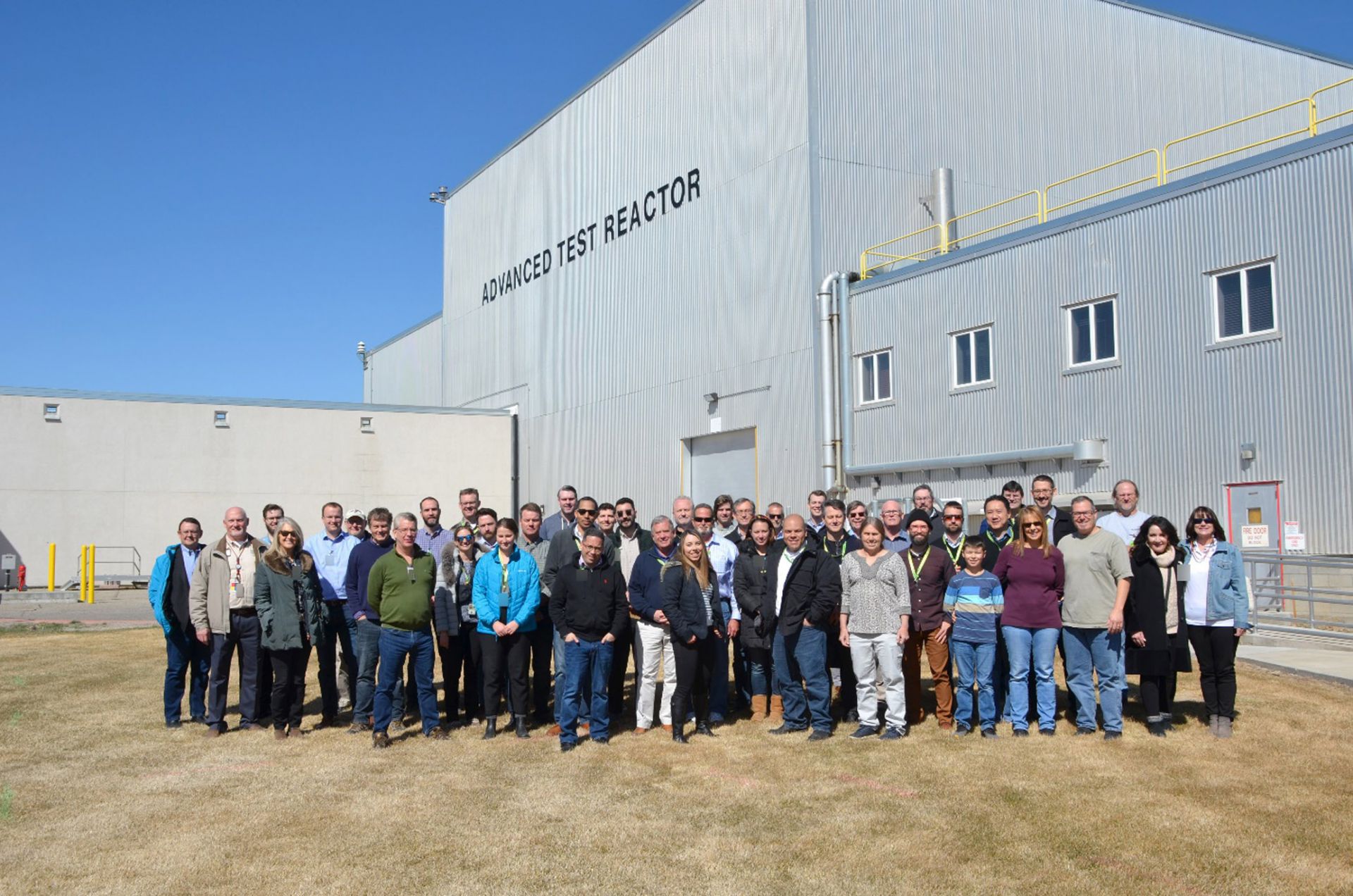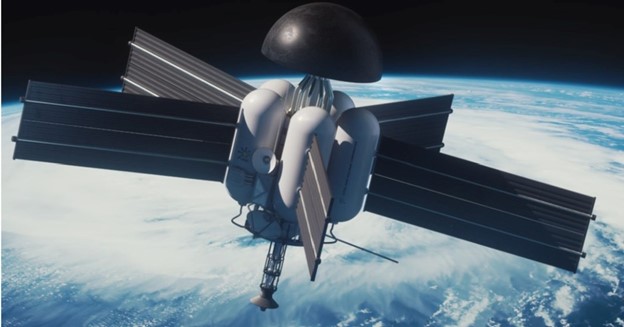A rendering of a data center powered by Radiant's Kaleidos microreactors (shown in the foreground). (Image: Ryan Seper)
Radiant Industries has announced a $100 million Series C funding round to be used primarily to complete its Kaleidos Development Unit (KDU) microreactor for testing in Idaho National Laboratory's Demonstration of Microreactor Experiments (DOME) facility within two years.
Jeff Waksman (left), Project Pele program manager for DOD-SCO, and John Wagner, INL director, at the planned testing site. (Photo: DOD)
The Department of Defense announced September 24 that it has broken ground on the site at Idaho National Laboratory’s Critical Infrastructure Test Range Complex (CITRC) where Project Pele, a transportable 1–5 MWe microreactor, will be tested. The DOD’s Strategic Capabilities Office (SCO) is in charge, on a mission to prove that a mobile microreactor can help meet the DOD’s increasing demand for resilient carbon-free energy for mission-critical operations in remote and austere environments.
AI-generated concept image. (Image: DARPA)
Nuclear power already has an energy density advantage over other sources of thermal electricity generation. But what if nuclear generation didn’t require a steam turbine? What if the radiation from a reactor was less a problem to be managed and more a source of energy? And what if an energy conversion technology could scale to fit nuclear power systems ranging from miniature batteries to the grid? The Defense Advanced Research Projects Agency (DARPA) Defense Sciences Office (DSO) is asking these types of questions in a request for information on High Power Direct Energy Conversion from Nuclear Power Systems, released August 1.
A concept image of NASA’s Fission Surface Power Project. (Image: NASA)
Imagine what our world would be like today without the benefits of electric energy. Think of the inventions and technologies that never would have been. Think of a world without power grids and the electricity that makes them run. Without this power, we’d find it difficult to maintain our industrial and manufacturing bases or enable advancements in the fields of medicine, communications, and computing.
Now consider the moon, our closest celestial neighbor about which we still know so little, waiting for modern-day explorers in spacesuits to unveil its secrets. Lunar exploration and a future lunar economy require reliable, long-lasting, clean sources of power. Nuclear fission answers that call. When assessing the application of nuclear power in space, three Ps should be considered: the present, the potential, and the partnerships.
A map of the potential reactor siting area (in green) at Eielson Air Force Base in Alaska provided during a pre-proposal conference in October 2022. (Graphic: Department of the Air Force)
Plans announced with fanfare sometimes falter in the face of competition or economics. Take NuScale Power’s plans for the Carbon Free Power Project in Idaho: The project was canceled in mid-November by NuScale and its first customer, Utah Associated Municipal Power Systems, after nearly a decade. The significance of that news depends on the observer. NuScale intends to focus on other sites and customers. Competitors may redouble efforts to tout their own designs and customer lists. Media found an opportunity to speculate about the future of advanced nuclear. And while many in the nuclear community believe the momentum in favor of new nuclear deployments is continuing—or even increasing as COP28 continues—others would caution against high hopes and point to the persistent obstacles of regulation, supply chain constraints, and financing costs.
Conceptual art of the Crowley-designed ship with a BWXT microreactor onboard. (Image: BWXT)
BWX Technologies is teaming with Crowley, a global shipping and energy supply chain company, under a memorandum of understanding to develop a ship with an onboard microreactor that could deliver power to users on shore via buoyed power cables. The concept, announced by both companies on September 20, is envisioned as a zero-carbon energy option for defense and disaster needs.
(Photo: Nielander/WikiCommons)
Westinghouse Electric Company says its eVinci microreactor technology is “100 percent factory built and assembled before it is shipped in a container to any location.” And “any location” is not restricted to planet Earth, given the company’s goal of sending a scaled-down version of eVinci to the lunar surface or on a mission to provide power in other space applications.
Industry professionals visit INL as part of a U.S. Nuclear Industry Council Conference. (Photo: INL)
The Department of Energy’s commitment to breaking down market barriers with initiatives, programs, and access to facilities is making it simpler and more efficient than ever for industry to partner with national laboratories. It is especially timely, as the country continues to face evolving security, economic, and clean energy challenges. Partnering opportunities via the DOE’s Cooperative Research and Development Agreements (CRADAs) and Strategic Partnership Projects (SPPs) are particularly prevalent in the commercial nuclear community and have seen a tremendous amount of funding and support dedicated to advancing the development, demonstration, and deployment of new reactor technologies.
Artist’s concept of the DRACO spacecraft, which will demonstrate a nuclear thermal rocket engine. (Image: DARPA)
NASA and the Defense Advanced Research Projects Agency (DARPA) have announced they will collaborate on plans to launch and test DARPA’s Demonstration Rocket for Agile Cislunar Operations (DRACO). DARPA has already worked with private companies on the baseline design for a fission reactor and rocket engine—and the spacecraft that will serve as an in-orbit test stand—and has solicited proposals for the next phase of work. Now NASA is climbing on board, deepening its existing ties to DRACO’s work in nuclear thermal propulsion (NTP) technology—an “enabling capability” required for NASA to meet its Moon to Mars Objectives and send crewed missions to Mars. NASA and DARPA representatives announced the development at the American Institute of Aeronautics and Astronautics SciTech Forum in National Harbor, Md., on January 24.
Aircraft line the runway at Eielson AFB in December 2020. (Photo: U.S. Air Force/Senior Airman Keith Holcomb)
The Department of the Air Force and the Defense Logistics Agency–Energy have released a request for proposals (RFP) for the construction and operation of a microreactor in central Alaska. The Department of Defense wants a 20-year supply of electricity and steam from a 1–5-MW microreactor, but the Eielson Air Force Base (AFB) Microreactor Pilot Program will go beyond a simple power purchase agreement and put the reactor through its paces with tests, at least annually, of the reactor’s walk-away safety and black-start capabilities. The final RFP is available at sam.gov.
Artist’s rendering of BWXT’s Project Pele transportable reactor modules arriving for set up and operation. (Image: BWXT)
BWX Technologies, Inc., will deliver the first microreactor in the United States under a contract awarded by the U.S. Department of Defense Strategic Capabilities Office (SCO), the company announced today. BWXT will have two years to build a transportable microreactor prototype to the SCO’s Project Pele specifications and deliver it to Idaho National Laboratory for testing under a cost-type contract valued at about $300 million.
Artist’s rendering of USNC spacecraft using EmberCore. (Image: DIU)
The Defense Innovation Unit (DIU), a Department of Defense organization focused on swiftly putting commercial technology to use in the U.S. military, has awarded contracts for two nuclear technologies—compact fusion and radioisotope heat—for spacecraft that could carry a high-power payload and freely maneuver in cislunar space. The objective is to accelerate ground and flight testing and launch a successful orbital prototype demonstration of each approach in 2027.
The Project Pele microreactor will be fueled by TRISO fuel particles like those shown here. (Photo: INL)




















